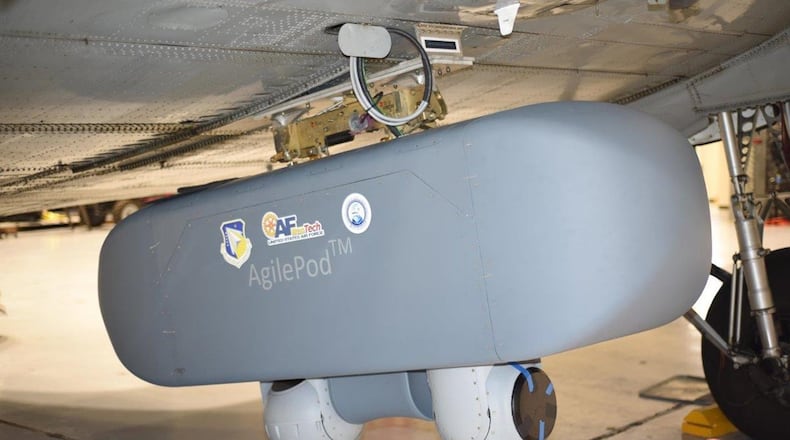“AgilePod was extremely successful during recent prototype testing on the DC-3 aircraft, and we’re moving forward to flight testing for the MQ-9,” said Capt. Russell Shirey, Blue Guardian program manager at the AFRL Sensors Directorate. “However, we learned that a ‘one size fits all’ AgilePod limits its ability to be used with a number of sensors on multiple platforms. The Mini-AgilePod project will essentially create a family of AgilePods, with small, medium and large-sized pods to host optimized sensors and enable the pod to fit an increased number of aircraft.”
AgilePod, the first physical system to be trademarked by the Air Force, is a multi-intelligence, open architecture, flight-line reconfigurable pod designed for the ISR community. Comprised of compartments ranging in length from 28 to 60 inches, the pod can be assembled in different configurations – similar in concept to Legos – to enable diverse sensor communication packages for a mission. For example, high-definition video, electro-optical and infrared sensors and radar can be deployed in a single AgilePod, eliminating the weight that might accompany multiple pieces of equipment to do the same.
Open Architecture sensor software, which is a set of common messages and interfaces that allow proprietary sensors and systems to integrate from a mechanical and electrical perspective, played a large role in the success of the original AgilePod, as it enabled multiple sensors to integrate on a single platform. This, along with a full Digital Thread capture of design decisions, will also play a role in the new Mini-AgilePod effort, ultimately saving time and money over the lifecycle of the system.
“Digital Thread captures the steps and decisions that lead to the ultimate physical design of a platform,” said Capt. Blake McCollum, chief engineer for AgilePod at the AFRL Materials and Manufacturing Directorate. “By having the data in a single package, you can disseminate it to others who may want to build a sensor to fit the platform, increasing capabilities while saving time and money that typically accompanies redesign and fit.”
The Mini-AgilePod effort has AFRL engineers working in conjunction with Leidos, the University of Dayton Research Institute and Advanced Consulting and Programmatics to optimize the design and configuration of the AgilePod platform. The resulting family of pods will be available in multiple sizes and take advantage of lessons learned from the original AgilePod design to make the new platform-agnostic family even better than the first.
“We are seeking ways to enable faster configuration of the pod by modifying fasteners and relocating screws and mounting structures. We are also using AFRL materials expertise to improve the outside skin of the pod and to address future maintenance and sustainment,” said Shirey.
A big change, according to Shirey, will be the use of an “open floor plan” in the new pod design.
“The first pod was designed as a series of blocks with five different modules,” he said. “We found that having interior bulkhead walls between modules limits air flow and adds weight. We’re now exploring an open floor plan with a reconfigurable middle section and removable nose and tail cones for the new design. Instead of hosting three different sensors in three different sections, we will have one long section with three sensors inside.”
An additional benefit will be the ability of the AgilePod family to act as a platform for integration and transition of lab technology, accelerating the pace by which AFRL can augment the ISR mission.
“Often laboratory teams in AFRL will build a great sensor, but they have a hard time integrating it into a platform,” said Erik Kvalheim, senior AgilePod engineer at the AFRL Materials and Manufacturing Directorate. “AgilePod gives them the opportunity to test new developments in the AgilePod and augment transition to a relevant platform. This is not just for sensors, but it is a carrier for developments in other capabilities such as enhanced targeting, communications, data storage and onboard processing.”
Ultimately, the new AgilePod effort is helping to build the future of ISR by ensuring the Air Force has affordable, enhanced systems with increased capabilities.
“We own the technical baseline, and we own the AgilePod brand,” said McCollum. “The ownership of the Digital Thread and integration of Open Architecture is big-picture stuff. We are building the future.”
About the Author
